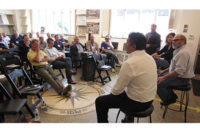Once again a contingency of fabricators came together during The International Surface Event, which was held at the Mandalay Bay Convention Center from January 18 to 20, 2017, to participate in a Fabricator Forum. The session is designed for fabricators to engage with their peers on issues pertinent to the stone industry. A moderator, Duane Naquin, president of Stone Interiors, as well as a panel of fabricators from across the U.S., led the discussion, encouraging audience participation.
The panelists included:
- Kimberly Homs, Great in Counters, Smithfield, RI
- Joe Durfee, American Floor Coverings, East Hartford, CT
- Blake Christensen, Valley View Granite, Tremonton, UT
- Rey Rodriguez, Ageless Stoneworks Inc., Houston, TX
The hour-and-a-half-long session passed by quickly, with audience members embracing the forum and asking questions and sharing experiences. “We are here to talk through your issues and help you out,” said Naquin, when addressing participants. Quartz surfacing remains a “hot” topic among fabricators of the stone industry, as well as management issues such as incentive programs to retain loyal employees. The following is a summary of some of the topics covered during this year’s Fabricator Forum.
The challenges with quartz
Many fabricators are cutting quartz, but it doesn’t come without its share of difficulties, judging by some of the comments expressed by audience members. One participant asked if anyone has noticed that some quartz slabs appear to have metal marks on them? “It personally has not happened to me, but it is becoming more common,” said Rodriguez. “I think all those quartz problems are more common than you think.”
“In one in five quartz slabs we see it,” added Naquin. “It’s extremely difficult to find beforehand. We tried some different top polishing methods [to remove the marks].”
“Unfortunately, the supplier will say it’s on you because you should have caught it sooner — before cutting,” said Durfee. “We have been burned a few times.”
Homs also said her company has encountered this problem, and explained to the audience the solution they found. “We set up a detail inspection table before cutting,” she said.
Still addressing issues with quartz surfacing, another participant asked what’s the tolerance of engineered stone? “I am seeing more warped slabs of engineered stone,” he said. “Is there anything to alleviate the tension before cutting?”
“We see that a lot,” explained Christensen. “We have had success double stacking them and letting them sit under water for the weekend. We have a floating table.”
“I have never done this, but I have talked to people who flip it over and make cuts on the backside,” said Durfee. “It’s very hard when each manufacturer makes up their own rules of what is and not acceptable.”
Company incentive programs
During the forum, the conversation turned to incentive programs. “What are you doing in your company?” asked a participant.
“The biggest thing is to explain the program and what they are to gain,” said Homs. “Friendly competition works well. We do a daily dashboard.”
“Human nature is we all need to feel appreciated,” said Christensen. “If we can understand measurable metrics, it’s a good start to an employee incentive program.”
Homs pointed out the importance of safety. “We do a quarterly incentive program,” she said. “If we go a month without an accident, we put names in a hat. At the end of the quarter, we pull names out and give out $50 and $100 gift cards. The employees love it. It feels good to be a part of something bigger than themselves.”
Another audience member explained his company does both individual and team incentive programs. “Teamwork works well,” he said. “The stronger guys want to help the weaker ones and teach them so they can win. Some of the individual programs we do includes tracking lineal footage being polished or cut. Our rework had been 30%. We got it down to 3% once we got the guys involved.”
A question was also raised regarding compact sintered surfaces. “Does anyone have advice on repairing it?” asked a participant.
“We haven’t done a ton of that material yet,” said Durfee. “If something does chip, we don’t take a chance because we can’t make it look good.”
Importing vs. suppliers
“Is it worth it to import or negotiate in the U.S. if you have say $20,000?” asked one fabricator. “It depends on your business model,” said Homs. “We were limited on space so it didn’t make sense to import. As we got into more commercial work and needed more slabs of one color, it made sense.
“If you do residential and offer 20 colors, it doesn’t make sense to bundle colors,” Homs went on to say. “We are fortunate that in New England there are a ton of wholesalers. I don’t know if [that’s the case] if say you are in Montana.”




